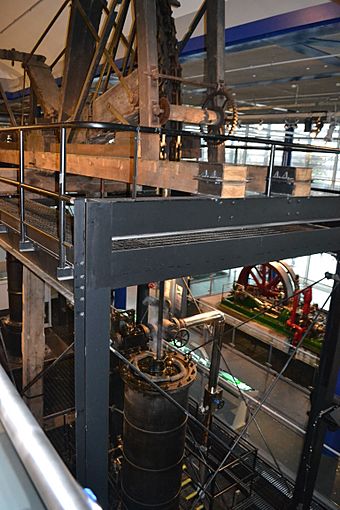Smethwick Engine facts for kids
Quick facts for kids Smethwick Engine |
|
|---|---|

The engine in steam at Birmingham's Thinktank museum
|
|
| Origins | |
| Type | Watt beam engine |
| Designer | James Watt |
| Maker | Boulton and Watt |
| Date | May 1779 |
| Country of origin | England |
| Former operator | Birmingham Canal Navigations |
| Purpose | Pumping water |
| Measurements | |
| Cylinders | 1 |
| Bore | 32 inches (81 cm) |
| Stroke | 8 feet (244 cm) |
| Preservation | |
| Collection | Birmingham Museums Trust |
| Location | Thinktank |
| Working | Yes |
The Smethwick Engine is a special type of steam engine called a Watt steam engine. It was built by a famous company called Boulton and Watt. This engine was first used in May 1779 near Birmingham, England.
Today, you can see the Smethwick Engine at the Thinktank, Birmingham Science Museum. It is known as the oldest working steam engine and the oldest working engine in the whole world!
Contents
The Engine's History
The Smethwick Engine was one of two steam engines used to pump water. This water was needed for the Old Main Line canal at Smethwick. The canal had a high point, or "summit level," which was about 491 feet (150 meters) high. The engines helped pump water back up to this level.
The other engine was also built by Boulton and Watt and was at the other end of the summit. Later, in 1804, a second engine was added next to the 1779 Smethwick Engine.
Why the Engines Were Needed
The local area did not have enough natural water to keep the canal full. The canal had six locks on each side of its highest point. Locks are like water elevators that help boats move up or down hills.
Originally, the canal designer, James Brindley, wanted to build a tunnel instead of locks. However, the ground was too soft and unstable. So, he couldn't build a tunnel with the tools and methods available back then.
In the 1780s, a new cutting (a deep ditch) was dug by John Smeaton. This helped remove three of the six locks on each side of the canal.
Changes to the Canal
In the 1820s, a new engineer named Thomas Telford built a new canal. This new canal ran next to the old one but was much deeper. It was at a lower level, about 453 feet (138 meters) high. This new cutting created the biggest man-made earthworks in the world at that time! The famous Galton Bridge was built over it.
Even with these big changes, the Smethwick Engine was still very important. Thomas Telford even built the Engine Arm Aqueduct. This aqueduct carried a smaller branch of the canal, called the Engine Arm, over his new main canal. This allowed coal to still be brought to the Smethwick Engine to power it.

The Engine's Later Life
By 1892, the original Smethwick Engine was getting old and too expensive to fix. So, a new engine was built in a new pumping house nearby. This new pumping house is now a protected historic building.
The original Smethwick Engine was taken away in 1897–98 to be saved. It was kept at a depot until the Birmingham City Council got it. Now, it is part of the Birmingham Museums collection. You can see it working at the Thinktank, Birmingham Science Museum in Millennium Point. It truly is the oldest working engine in the world!

The old engine house was taken down in 1897. You can still see where it used to be on Bridge Street North in Smethwick. If you want to learn more, you can arrange tours of the site through the Galton Valley Canal Heritage Centre. This center is located in the New Smethwick Pumping Station.
See also
- Canals of the United Kingdom
- History of the British canal system
- Old Bess (beam engine) – another old Watt steam engine


